Reactive Molecular Dynamics Simulations of Polystyrene Pyrolysis
Abstract
:1. Introduction
2. Results and Discussions
2.1. Effects of Heating Rate on the Pyrolysis Products
2.2. Effects of Target Temperature on the Pyrolysis Products
2.3. Tissue Characterization and Carbon Ring Analysis of Pyrolysis Products
2.3.1. Carbon Ring Evolution with Different Heating Rates
2.3.2. Carbon Ring Evolution at Different Target Temperatures
2.3.3. Kinetic Analysis of PS Pyrolysis
2.3.4. Pore Size Analysis
3. Methods and Materials
3.1. Modeling of Pyrolysis Precursor
3.2. ReaxFF-MD Details for Polystyrene Pyrolysis
4. Conclusions
Supplementary Materials
Author Contributions
Funding
Institutional Review Board Statement
Informed Consent Statement
Data Availability Statement
Conflicts of Interest
References
- Ma, C.; Min, J.; Gong, J.; Liu, X.; Mu, X.; Chen, X.; Tang, T. Transforming polystyrene waste into 3D hierarchically porous carbon for high-performance supercapacitors. Chemosphere 2020, 253, 126755. [Google Scholar] [CrossRef] [PubMed]
- Plaza-Recobert, M.; Trautwein, G.; Pérez-Cadenas, M.; Alcañiz-Monge, J. Preparation of binderless activated carbon monoliths from cocoa bean husk. Microporous Mesoporous Mater. 2017, 243, 28–38. [Google Scholar] [CrossRef]
- Li, S.; Han, K.; Li, J.; Li, M.; Lu, C. Preparation and characterization of super activated carbon produced from gulfweed by KOH activation. Microporous Mesoporous Mater. 2017, 243, 291–300. [Google Scholar] [CrossRef]
- Wang, J.; Nie, P.; Ding, B.; Dong, S.; Hao, X.; Dou, H.; Zhang, X. Biomass derived carbon for energy storage devices. J. Mater. Chem. A 2017, 5, 2411–2428. [Google Scholar] [CrossRef]
- Li, J.; Michalkiewicz, B.; Min, J.; Ma, C.; Chen, X.; Gong, J.; Mijowska, E.; Tang, T. Selective preparation of biomass-derived porous carbon with controllable pore sizes toward highly efficient CO2 capture. Chem. Eng. J. 2019, 360, 250–259. [Google Scholar] [CrossRef]
- Liu, X.; Ma, C.; Li, J.; Zielinska, B.; Kalenczuk, R.J.; Chen, X.; Chu, P.K.; Tang, T.; Mijowska, E. Biomass-derived robust three-dimensional porous carbon for high volumetric performance supercapacitors. J. Power Sources 2019, 412, 1–9. [Google Scholar] [CrossRef]
- Sun, F.; Gao, J.; Yang, Y.; Zhu, Y.; Wang, L.; Pi, X.; Liu, X.; Qu, Z.; Wu, S.; Qin, Y. One-step ammonia activation of Zhundong coal generating nitrogen-doped microporous carbon for gas adsorption and energy storage. Carbon 2016, 109, 747–754. [Google Scholar] [CrossRef]
- Chen, C.; Yan, D.; Luo, X.; Gao, W.; Huang, G.; Han, Z.; Zeng, Y.; Zhu, Z. Construction of Core–Shell NiMoO4@Ni-Co-S Nanorods as Advanced Electrodes for High-Performance Asymmetric Supercapacitors. ACS Appl. Mater. Interfaces 2018, 10, 4662–4671. [Google Scholar] [CrossRef]
- Kocirík, M.; Brych, J.; Hradil, J. Carbonization of bead-shaped polymers for application in adsorption and in composite membranes. Carbon 2001, 39, 1919–1928. [Google Scholar] [CrossRef]
- Jiang, Z.; Liu, Y.; Zeng, G.; Xu, W.; Zheng, B.; Tan, X.; Wang, S. Adsorption of hexavalent chromium by polyacrylonitrile (PAN)-based activated carbon fibers from aqueous solution. RSC Adv. 2015, 5, 25389–25397. [Google Scholar] [CrossRef]
- de Paula, F.G.F.; de Castro, M.C.M.; Ortega, P.F.R.; Blanco, C.; Lavall, R.L.; Santamaría, R. High value activated carbons from waste polystyrene foams. Microporous Mesoporous Mater. 2018, 267, 181–184. [Google Scholar] [CrossRef]
- Gong, J.; Chen, X.; Tang, T. Recent progress in controlled carbonization of (waste) polymers. Prog. Polym. Sci. 2019, 94, 1–32. [Google Scholar] [CrossRef]
- Zhang, Y.; Shen, Z.; Yu, Y.; Liu, L.; Wang, G.; Chen, A. Porous carbon derived from waste polystyrene foam for supercapacitor. J. Mater. Sci. Vol. 2018, 53, 12115–12122. [Google Scholar] [CrossRef]
- Tang, T.; Chen, X.; Meng, X.; Chen, H.; Ding, Y. Synthesis of Multiwalled Carbon Nanotubes by Catalytic Combustion of Polypropylene. Angew. Chem. 2005, 117, 1541–1544. [Google Scholar] [CrossRef]
- Gottlieb, E.; Matyjaszewsk, K.; Kowalewski, T. Polymer-Based Synthetic Routes to Carbon-Based Metal-Free Catalysts. Adv. Mater. 2019, 31, 1804626. [Google Scholar] [CrossRef]
- Lee, G.; In Park, S.; Yi Shin, H.; Joh, H.I.; Kim, S.S.; Lee, S. Simultaneous reactions of sulfonation and condensation for high-yield conversion of polystyrene into carbonaceous material. J. Ind. Eng. Chem. 2023, 122, 426–436. [Google Scholar] [CrossRef]
- Zhao, J.; Lai, H.; Lyu, Z.; Jiang, Y.; Xie, K.; Wang, X.; Wu, Q.; Yang, L.; Jin, Z.; Ma, Y.; et al. Hydrophilic Hierarchical Nitrogen-Doped Carbon Nanocages for Ultrahigh Supercapacitive Performance. Adv. Mater. 2015, 27, 3541–3545. [Google Scholar] [CrossRef]
- Zhang, L.H.; He, B.; Li, W.C.; Lu, A.H. Surface Free Energy-Induced Assembly to the Synthesis of Grid-Like Multicavity Carbon Spheres with High Level In-Cavity Encapsulation for Lithium–Sulfur Cathode. Adv. Mater. 2017, 22, 1701518. [Google Scholar] [CrossRef]
- Chen, Y.; Zhou, M.; Huang, Y.; Ma, Y.; Yan, L.; Zhou, X.; Ma, X.; Zhao, X.; Chen, C.; Bai, J.; et al. Enhanced ethanol oxidation over Pd nanoparticles supported porous graphene-doped MXene using polystyrene particles as sacrifcial templates. Rare Met. 2022, 41, 3170–3179. [Google Scholar] [CrossRef]
- Maafa, I. Pyrolysis of Polystyrene Waste: A Review. Polymers 2021, 13, 225. [Google Scholar] [CrossRef]
- Gonzalez-Aguilar, A.M.; Pérez-García, V.; Riesco-Ávila, J.M. A Thermo-Catalytic Pyrolysis of Polystyrene Waste Review: A Systematic, Statistical, and Bibliometric Approach. Polymers 2023, 15, 1582. [Google Scholar] [CrossRef]
- Shakya, B.D. Pyrolysis of Waste Plastics to Generate Useful Fuel Containing Hydrogen Using a Solar Thermochemical Process. Ph.D. Thesis, The University of Sydney, Sydney, Australia, 2007. [Google Scholar]
- Poutsma, M.L. Reexamination of the Pyrolysis of Polyethylene: Data Needs, Free-Radical Mechanistic Considerations, and Thermochemical Kinetic Simulation of Initial Product-Forming Pathways. Macromolecules 2003, 6, 8931–8957. [Google Scholar] [CrossRef]
- Kruse, T.M.; Wong, H.W.; Broadbelt, L.J. Mechanistic Modeling of Polymer Pyrolysis: Polypropylene. Macromolecules 2003, 36, 9594–9607. [Google Scholar] [CrossRef]
- Levine, S.E.; Broadbelt, L.J. Reaction pathways to dimer in polystyrene pyrolysis: A mechanistic modeling study. Polym. Degrad. Stab. 2008, 93, 941–951. [Google Scholar] [CrossRef]
- Arena, U.; Mastellone, M.L.; Giovanni, G.; Boccaleri, E. An innovative process for mass production of multi-wall carbon nanotubes by means of low-cost pyrolysis of polyolefins. Polym. Degrad. Stab. 2006, 91, 763–768. [Google Scholar] [CrossRef]
- Gong, J.; Michalkiewicz, B.; Chen, X.; Mijowska, E.; Liu, J.; Jiang, Z.; Wen, X.; Tang, T. Sustainable Conversion of Mixed Plastics into Porous Carbon Nanosheets with High Performances in Uptake of Carbon Dioxide and Storage of Hydrogen. ACS Sustain. Chem. Eng. 2014, 2, 2837–2844. [Google Scholar] [CrossRef]
- Onwudili, J.A.; Insura, N.; Williams, P.T. Composition of products from the pyrolysis of polyethylene and polystyrene in a closed batch reactor: Effects of temperature and residence time. J. Anal. Appl. Pyrolysis 2009, 86, 293–303. [Google Scholar] [CrossRef]
- Ahmed, I.I.; Gupta, A.K. Hydrogen production from polystyrene pyrolysis and gasification: Characteristics and kinetics. Int. J. Hydrogen Energy 2009, 34, 6253–6264. [Google Scholar] [CrossRef]
- Achilias, D.S.; Kanellopoulou, I.; Megalokonomos, P.; Antonakou, E.; Lappas, A.A. Chemical Recycling of Polystyrene by Pyrolysis: Potential Use of the Liquid Product for the Reproduction of Polymer. Macromol. Mater. Eng. 2007, 292, 923–934. [Google Scholar] [CrossRef]
- Mertinkat, J.; Kirsten, A.; Predel, M.; Kaminsky, W. Cracking catalysts used as fluidized bed material in the Hamburg pyrolysis process. J. Anal. Appl. Pyrolysis 1999, 49, 87–95. [Google Scholar] [CrossRef]
- Li, S.; Bian, F.; Meng, X.; Zhai, D.; Yang, H.; Qin, G. Ring structure characterization of nanoporous carbon materials prepared by thermal conversion of fullerenes: Insights from ReaxFF molecular dynamics simulations. Carbon 2022, 189, 484–492. [Google Scholar] [CrossRef]
- Kim, S.; Kim, Y.C.; Jang, E.S. Identification of Reaction Model of Pyrolysis Reaction of HDPE. Chem. Lett. 2004, 33, 1310–1311. [Google Scholar] [CrossRef]
- Lu, X.; Wang, X.; Li, Q.; Huang, X.; Han, S.; Wang, G. A ReaxFF-based molecular dynamics study of the pyrolysis mechanism of polyimide. Polym. Degrad. Stab. 2015, 114, 72–80. [Google Scholar] [CrossRef]
- Zhao, T.; Li, T.; Xin, Z.; Zou, L.; Zhang, L. A ReaxFF-Based Molecular Dynamics Simulation of the PyrolysisMechanism for Polycarbonate. Energy Fuels 2018, 32, 2156–2162. [Google Scholar] [CrossRef]
- Liu, X.; Li, X.; Liu, J.; Wang, Z.; Kong, B.; Gong, X.; Yang, X.; Lin, W.; Guo, L. Study of high density polyethylene (HDPE) pyrolysis with reactive molecular dynamics. Polym. Degrad. Stab. 2014, 104, 62–70. [Google Scholar] [CrossRef]
- Saha, B.; Schatz, G.C. Carbonization in Polyacrylonitrile (PAN) Based Carbon Fibers Studied by ReaxFF Molecular Dynamics Simulations. J. Phys. Chem. B 2012, 116, 4684–4692. [Google Scholar] [CrossRef]
- Wang, Q.; Wang, J.; Li, J.; Tan, N.; Li, X. Reactive molecular dynamics simulation and chemical kinetic modeling of pyrolysis and combustion of n-dodecane. Combust. Flame 2011, 158, 217–226. [Google Scholar] [CrossRef]
- Salmon, E.; van Duin, A.C.T.; Lorant, F.; Marquaire, P.M.; Goddard, W.A., III. Early maturation processes in coal. Part 2: Reactive dynamics simulations using the ReaxFF reactive force field on Morwell Brown coal structures. Org. Geochem. 2009, 40, 1195–1209. [Google Scholar] [CrossRef]
- Zhang, L.; Zybin, S.V.; Van Duin, A.C.T.; Goddard, W.A., III. Modeling High Rate Impact Sensitivity of Perfect RDX and HMX Crystals by ReaxFF Reactive Dynamics. J. Energetic Mater. 2010, 28, 92–127. [Google Scholar] [CrossRef]
- Humphrey, W.; Dalke, A.; Schulten, K. VMD: Visual Molecular Dynamics. J. Mol. Graph. 1996, 14, 33–38. [Google Scholar] [CrossRef]
- Stukowski, A. Visualization and analysis of atomistic simulation data with OVITO–the Open Visualization Tool. Model. Simul. Mater. Sci. Eng. 2009, 18, 015012. [Google Scholar] [CrossRef]
- Willems, T.F.; Rycroft, C.; Kazi, M.; Meza, J.C.; Haranczyk, M. Algorithms and tools for high-throughput geometry-based analysis of crystalline porous materials. Microporous Mesoporous Mater. 2012, 149, 134–141. [Google Scholar] [CrossRef]
- Kowalik, M.; Ashraf, C.; Damirchi, B.; Akbarian, D.; Rajabpour, S.; van Duin, A.C.T. Atomistic Scale Analysis of the Carbonization Process for C/H/O/N-Based Polymers with the ReaxFF Reactive Force Field. J. Phys. Chem. B 2019, 123, 5357–5367. [Google Scholar] [CrossRef]
- Diao, Z.; Zhao, Y.; Chen, B.; Duan, C.; Song, S. ReaxFF reactive force field for molecular dynamics simulations of epoxy resin thermal decomposition with model compound. J. Anal. Appl. Pyrolysis 2013, 104, 618–624. [Google Scholar] [CrossRef]
- Desai, T.G.; Lawson, J.W.; Keblinski, P. Modeling initial stage of phenolic pyrolysis: Graphitic precursor formation and interfacial effects. Polymer 2011, 52, 577–585. [Google Scholar] [CrossRef]
- Zheng, M.; Li, X.; Liu, J.; Wang, Z.; Gong, X.; Guo, L.; Song, W. Pyrolysis of Liulin Coal Simulated by GPU-Based ReaxFF MD with Cheminformatics Analysis. Energy Fuels 2014, 28, 522–534. [Google Scholar] [CrossRef]
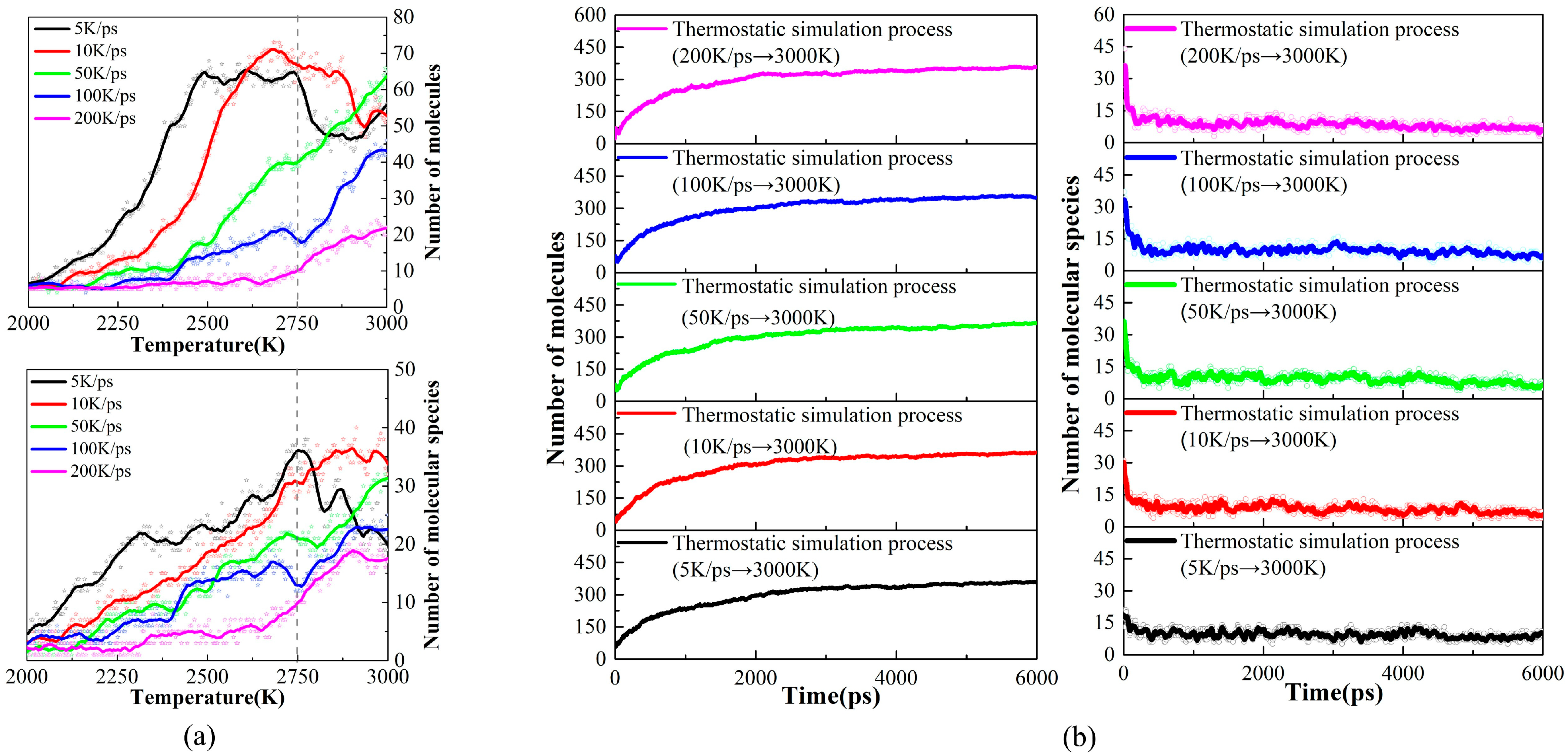
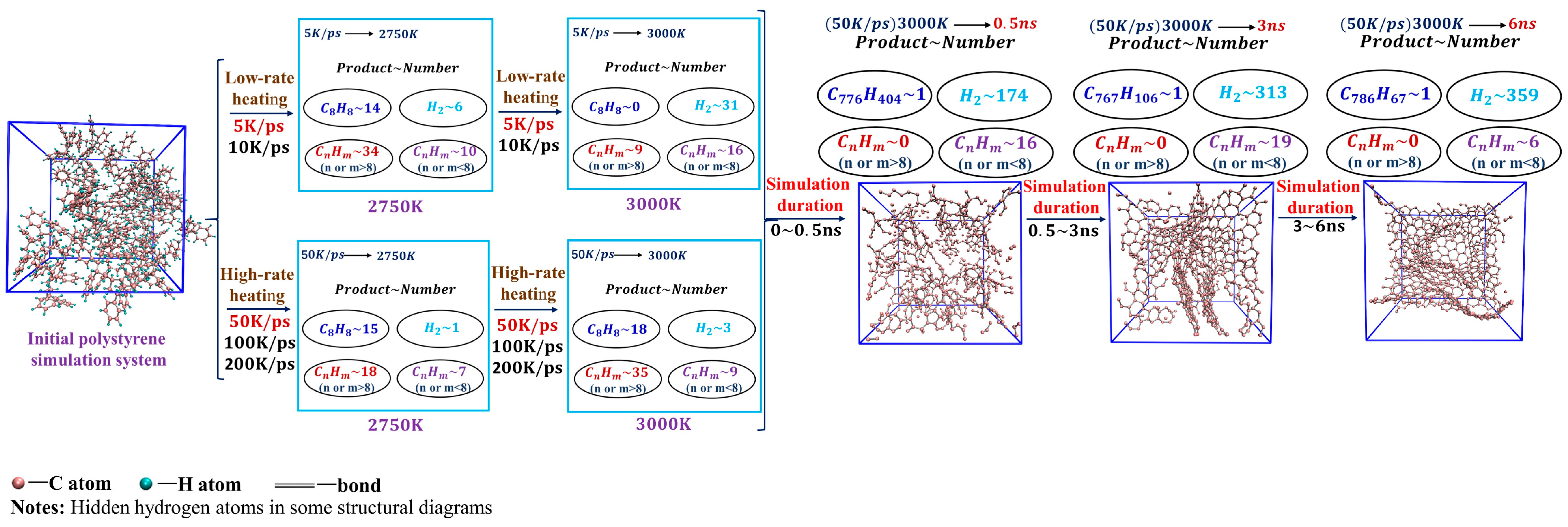

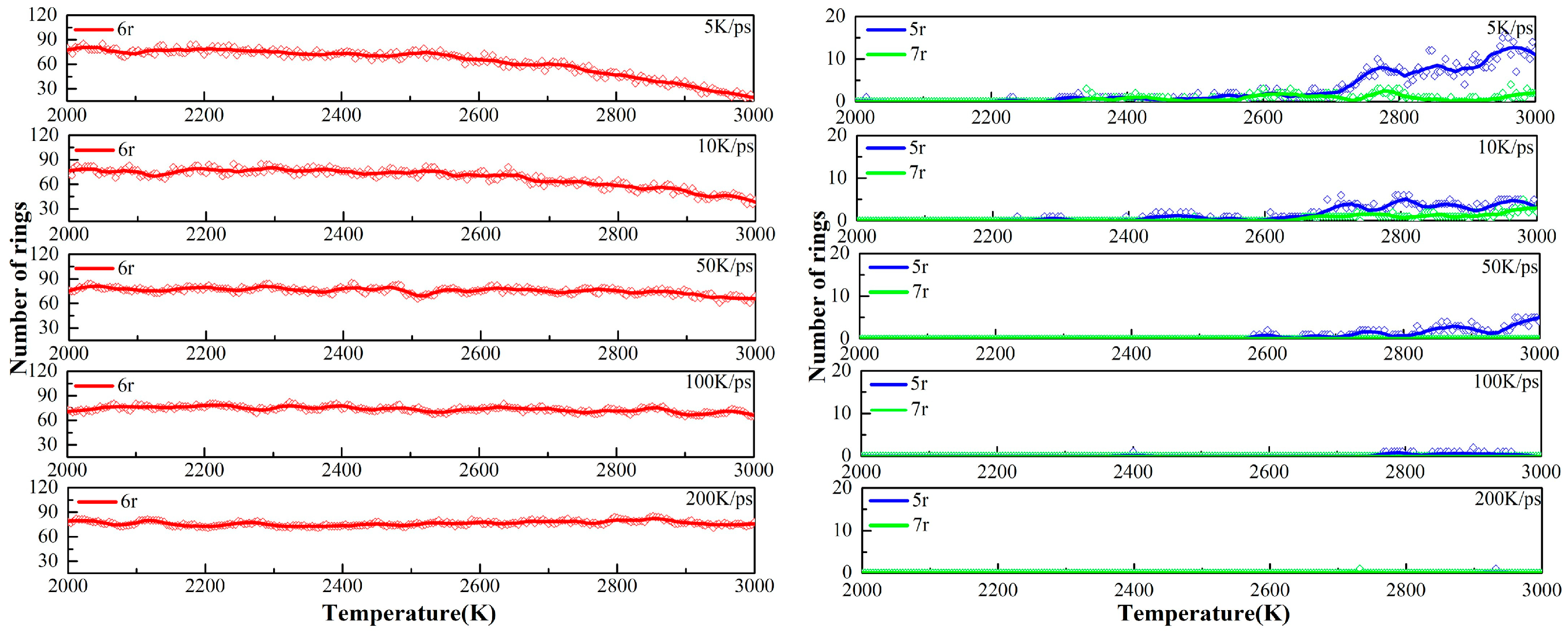
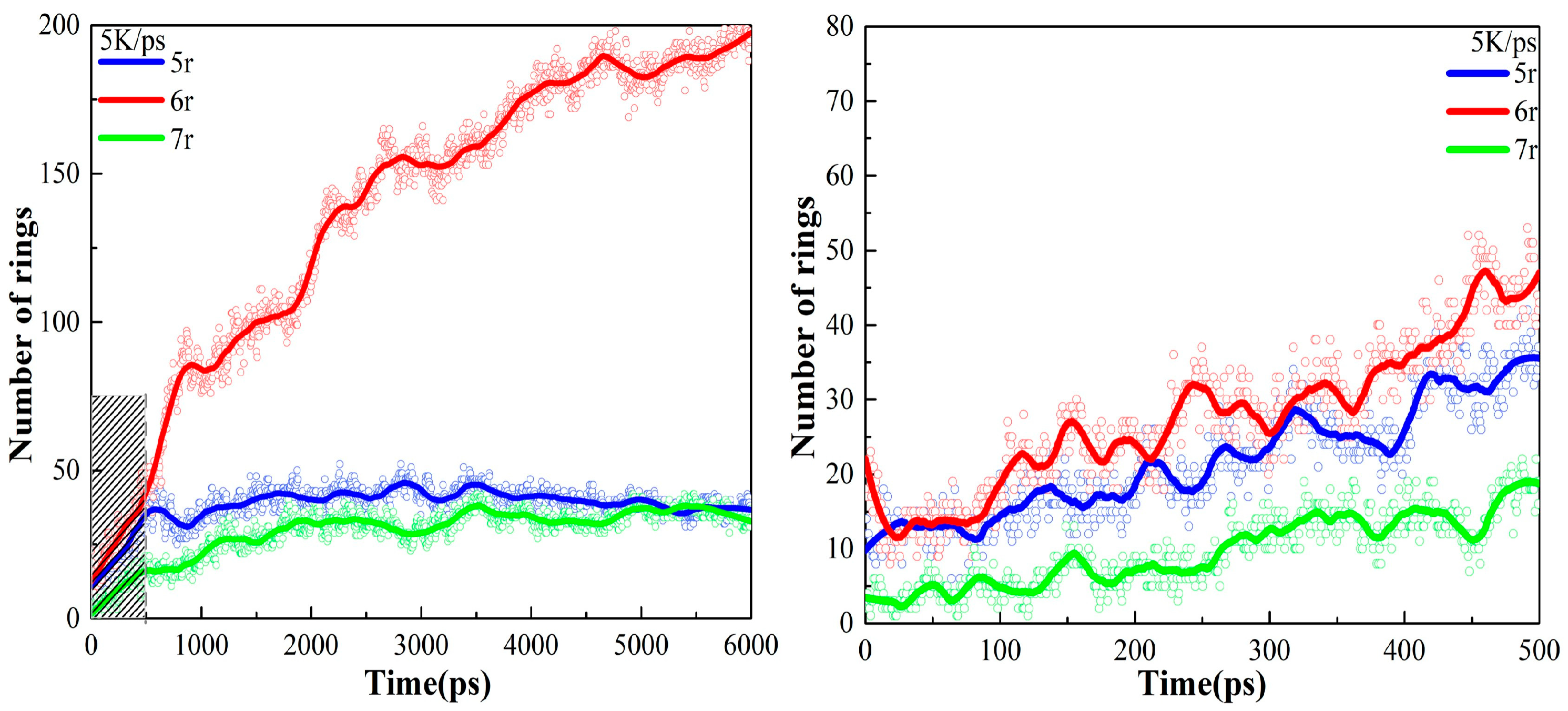
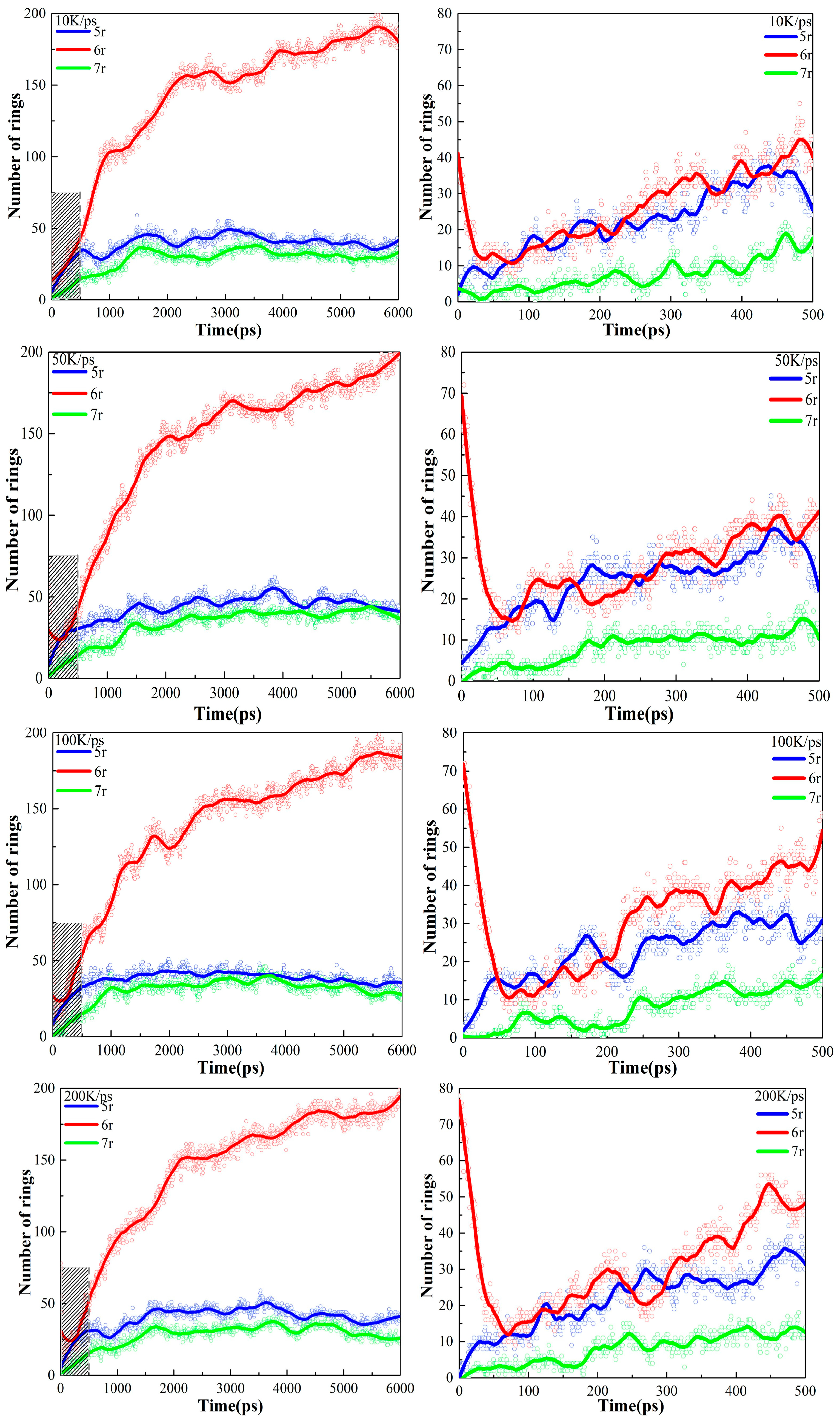
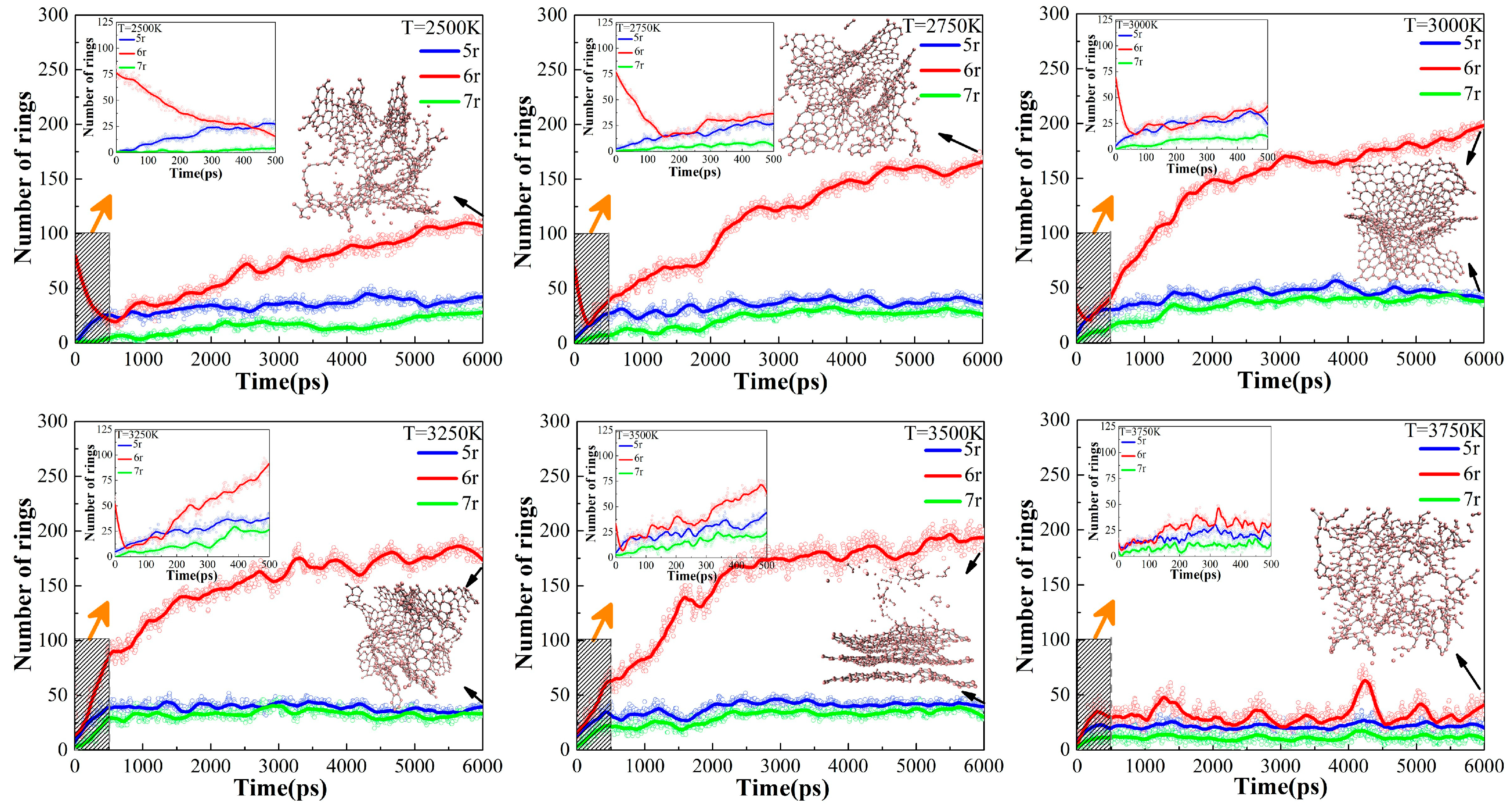


| Reaction Model | R-Square | ||
|---|---|---|---|
| Power law (n = 3/2) | 0.8207 | ||
| One-dimensional diffusion | 0.9072 | ||
| Mample (first-order) | 0.9659 | ||
| Contracting sphere | 0.8809 | ||
| Contracting cylinder | 0.7959 |
| Temperature (K) | |
|---|---|
| 2750 K | 1.94 × 108 |
| 3000 K | 2.51 × 108 |
| 3250 K | 6.16 × 108 |
| 3500 K | 1.06 × 109 |
| Temperature | Aperture Size | Proportion |
|---|---|---|
| 2500 K | <5.0 | 9.0% |
| 5.0–9.0 | 44.7% | |
| 9.0–11.5 | 30.1% | |
| >11.5 | 16.2% | |
| 2750 K | <5.0 | 9.1% |
| 5.0–9.0 | 55.4% | |
| 9.0–11.5 | 27.5% | |
| >11.5 | 8.0% | |
| 3000 K | <5.0 | 8.3% |
| 5.0–9.0 | 41.8% | |
| 9.0–11.5 | 39.9% | |
| >11.5 | 10.0% | |
| 3250 K | <5.0 | 8.4% |
| 5.0–9.0 | 40.0% | |
| 9.0–11.5 | 36.2% | |
| >11.5 | 15.4% | |
| 3500 K | <5.0 | 10.0% |
| 5.0–9.0 | 42.0% | |
| 9.0–11.5 | 32.2% | |
| >11.5 | 15.8% | |
| 3750 K | <5.0 | 8.9% |
| 5.0–9.0 | 44.2% | |
| 9.0–11.5 | 33.6% | |
| >11.5 | 13.3% |
Disclaimer/Publisher’s Note: The statements, opinions and data contained in all publications are solely those of the individual author(s) and contributor(s) and not of MDPI and/or the editor(s). MDPI and/or the editor(s) disclaim responsibility for any injury to people or property resulting from any ideas, methods, instructions or products referred to in the content. |
© 2023 by the authors. Licensee MDPI, Basel, Switzerland. This article is an open access article distributed under the terms and conditions of the Creative Commons Attribution (CC BY) license (https://creativecommons.org/licenses/by/4.0/).
Share and Cite
Li, C.; Yang, Z.; Wu, X.; Shao, S.; Meng, X.; Qin, G. Reactive Molecular Dynamics Simulations of Polystyrene Pyrolysis. Int. J. Mol. Sci. 2023, 24, 16403. https://doi.org/10.3390/ijms242216403
Li C, Yang Z, Wu X, Shao S, Meng X, Qin G. Reactive Molecular Dynamics Simulations of Polystyrene Pyrolysis. International Journal of Molecular Sciences. 2023; 24(22):16403. https://doi.org/10.3390/ijms242216403
Chicago/Turabian StyleLi, Chao, Zhaoying Yang, Xinge Wu, Shuai Shao, Xiangying Meng, and Gaowu Qin. 2023. "Reactive Molecular Dynamics Simulations of Polystyrene Pyrolysis" International Journal of Molecular Sciences 24, no. 22: 16403. https://doi.org/10.3390/ijms242216403
APA StyleLi, C., Yang, Z., Wu, X., Shao, S., Meng, X., & Qin, G. (2023). Reactive Molecular Dynamics Simulations of Polystyrene Pyrolysis. International Journal of Molecular Sciences, 24(22), 16403. https://doi.org/10.3390/ijms242216403






